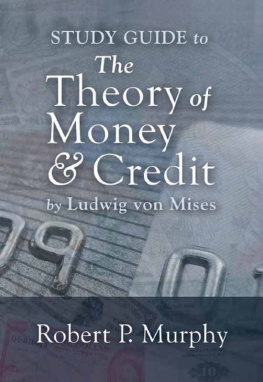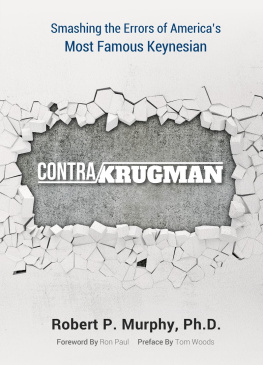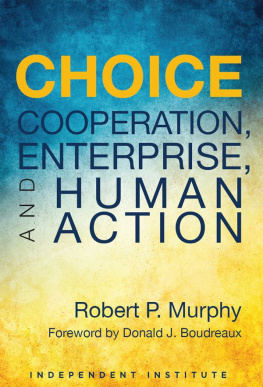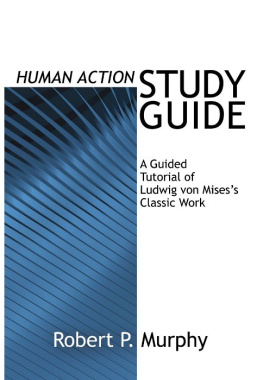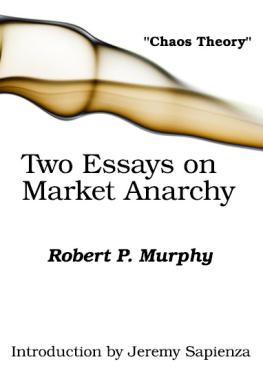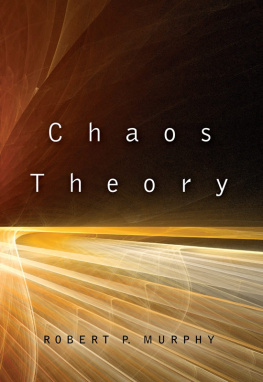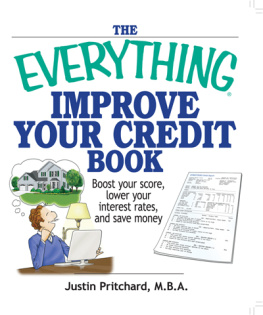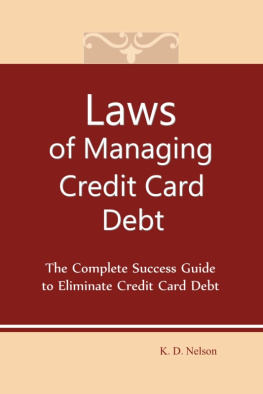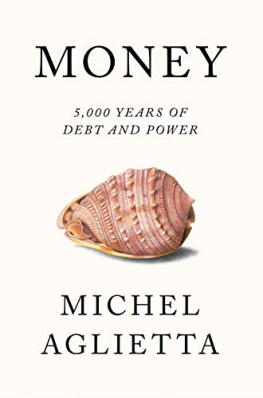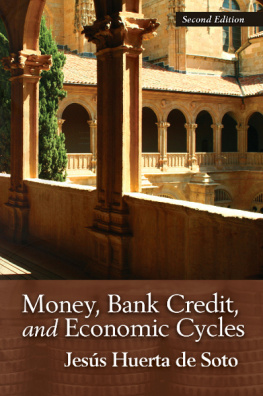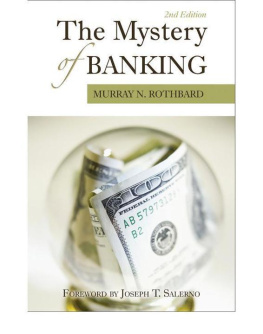STUDY GUIDE TO
THE THEORY OF
MONEY AND CREDIT
Study Guide
TO
THE THEORY OF
MONEY AND CREDIT
LUDWIG VON MISES
Robert P. Murphy
LVMI
MISES INSTITUTE

The Theory of Money and Credit was translated from the German by H.E. Batson and published by Jonathan Cape (London) in 1934.
Copyright 2011 by the Ludwig von Mises Institute
Published under the Creative Commons Attribution License 3.0.
http://creativecommons.org/licenses/by/3.0/
Ludwig von Mises Institute
518 West Magnolia Avenue
Auburn, Alabama 36832
Mises.org
ISBN: 978-1-61016-235-7
CONTENTS
PREFACE
When Joe the Plumbera small business owner who became a hero among conservatives when he challenged candidate Barack Obamas proposed tax hikes in the 2008 presidential campaigncompiled a list of Christmas book recommendations for The American Spectator, he included The Theory of Money and Credit, saying it was important reading for these troubled times. Although Austrians were glad that someone was bringing attention to Misess classic work, many were understandably skeptical. After all, The Theory of Money and Credit is a hard book to read.
The present study guide seeks to change that common impression. In preparing it, I have found that Misess work can be difficult at times, but there is a definite method behind it. In other words, if the reader will put in the effort to work through the book methodically, he or she will see that Mises systematically builds his argument from one chapter to the next. With the help of this study guide, even the layperson will be able to unlock the amazing insights contained in this tome, first published a century ago.
One of the most enjoyable surprises for me was to discover just how impressive an economist Ludwig von Mises really was, even at a relatively young age. In this single work, Mises integrated (what we now call) microeconomics with macroeconomics. He successfully applied subjectivist, marginal utility theory to the case of moneya task that had eluded earlier theorists in the Austrian tradition. As if that werent enough, Mises gave a systematic explanation of the boom-bust cycle, blaming it on the artificial expansion of bank credit and the corresponding reduction of the money rate of interest below the natural rate.
These accomplishments alone would have earned Mises an important seat in the history of economic thought. Yet upon my most recent reading, I realized that Mises showcases much more of his talent. For one thing, he displays a thorough command of the relevant literature, not only in pure economic theory but also in applied topics such as money and banking. He also shows a practical understanding of actual financial markets, which often behave differently from the depiction in academic writings. In the final section of the book (written after the original release), Mises offers very wise policy recommendations for returning to sound money.
The format of the study guide follows the 1953 edition of The Theory of Money and Credit published by the Mises Institute. I follow Misess work very closely, down to the individual section headings. Each chapter contains an overall summary (except for very short chapters), followed by a detailed outline. Then I include a section on either Notable Contributions or Technical Notes. There is also a list of new terms for each chapter (with a full list included in the back as a glossary) and finally a list of five study questions to ensure that the reader is grasping the essential points of each chapter.
In order to modernize the style, hyphens have been dropped, and in a few instances, spelling has been updated. However, no content has been altered from the English translation as published by the Mises Institute.
I hope that this study guide eases the understandable intimidation factor and allows a new generation of readers to experience the wealth of wisdom contained in Misess first major work. As an insightful plumber (and layperson) has remarked, it is important reading for these troubled times.
Robert P. Murphy
Nashville, Tennessee
July, 2011
PART I
THE NATURE OF MONEY
CHAPTER I
THE FUNCTION OF MONEY
Summary
Money is necessary in a society based on private property and the division of labor. The function of money is to facilitate these trades: Money is a commonly used medium of exchange.
In a direct exchange, people accept goods in trade that they intend to personally use, whether for consumption or production. There is no medium of exchange involved in the transaction.
In an indirect exchange, at least one person in the transaction accepts a good that he intends to trade away in the future for something else. The item that is accepted in the first trade is a medium of exchange.
Even before the use of money, traders would have quickly discovered the benefits of indirect exchanges, and the use of media of exchange to facilitate them. Some goods would have had a far broader market than others. A trader who came to market with an unmarketable good would place himself in a more advantageous bargaining position if he engaged in an indirect exchange, by trading his good for something that was more marketable.
Because every trader would act in this fashion, those goods that were initially more marketable, would see their marketability enhanced even further. Over time, a community would gravitate to one or a few commodities that would be acceptable to everyone in trade. This is how money emerged from an initial state of barter. Historically the market has often chosen gold and silver as money.
Although other writers outline other functions of moneysuch as a standard of deferred payments or a store of valuethese all flow from its definition: money is a commonly accepted medium of exchange.
Chapter Outline
1. The General Economic Conditions for the Use of Money
A person living by himself on a tropical island would not need money. Several people living in the same household would not need money either, so long as they produced everything they needed within the household. Even an entire communityconsisting of thousands or millions of households, each of which specialized in producing different goods and servicescould get by without the use of money, assuming there were a central group or person who acted as a planner and told everyone what to make, and decided which portion of the total output each person would get to consume.
However, in a society based on the division of labor, and where private individuals own both consumption goods (TVs, radios, Big Macs) and producer goods (tractors, factories, copper mines), money is essential. In such a society, there is no one person or group who decides how scarce resources will be deployed. Each individual must make his or her own plans, which usually require exchanging property for other peoples property. The function of money is to facilitate these trades: Money is a commonly used medium of exchange.
2. The Origin of Money
In a direct exchange, people accept goods in trade that they intend to personally use, whether for consumption or production. For example, suppose Alan has a muffin but he is really hungry for fish. Bill, on the other hand, has a net (which can be used to catch fish) that he doesnt really want, but he thinks Alans muffin looks delicious. If Alan trades his muffin for Bills net, this is a direct exchange. There is no medium of exchange involved in the transaction.
Next page
